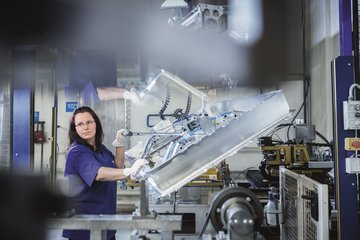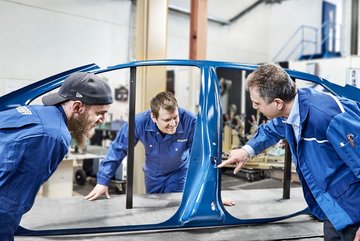
BANDEJAS PARA BATERÍAS
Llevamos más de una década fabricando bandejas para baterías para clientes de renombre.
A pesar de este historial probado, no nos conformamos con el status quo
Invertimos continuamente en ampliar nuestra experiencia y participamos en proyectos de investigación y desarrollo previo porque queremos saber hoy a qué desafíos se enfrentarán nuestros clientes mañana. Y queremos ofrecerles soluciones óptimas, por ejemplo, mostrándoles qué opciones hay disponibles para adaptar las bandejas para baterías a las condiciones cambiantes.
Sabías...
Las bandejas de batería son los elementos centrales de los coches eléctricos. Deben cumplir requisitos complejos como la tensión mecánica, el uso óptimo del espacio de instalación, el control de la temperatura de las baterías, la estanqueidad y la seguridad en caso de colisión. En particular, deben evitar que las baterías pongan en peligro a los pasajeros en caso de accidente.
BENTELER ya cuenta con muchos años de experiencia en la producción de bandejas de batería. La primera bandeja fue fabricada por BENTELER en 2014 en nuestra planta de Jablonec, República Checa.
Bandejas para Baterías
Proyecto de investigación
"Desarrollo de un concepto para una carcasa de batería de acero, teniendo en cuenta especialmente la tecnología de unión y la protección contra la corrosión".El objetivo de este proyecto colectivo en el que participan socios industriales es aprovechar las ventajas de los aceros de ultraalta resistencia en el diseño conceptual de carcasas de baterías, teniendo en cuenta especialmente las limitaciones de la libertad de diseño. El diseño conceptual también tiene en cuenta especialmente los requisitos y soluciones resultantes del proyecto global en lo que respecta a la protección contra la corrosión, la estanqueidad y la tecnología de unión. Además, en este proyecto se realizará un análisis completo del ciclo de vida para evaluar también el impacto medioambiental de forma holística en comparación con un modelo de referencia.
El proyecto colectivo está financiado por BMWK en el marco de la convocatoria de propuestas del IGF "Tecnologías líderes para el cambio de rumbo energético" y supervisado por la Asociación de Investigación de Aceros y Metales (FOSTA). La Asociación de Investigación de Automóvil y Tecnología de la Construcción (FAT) y la Asociación de Investigación de Pigmentos y Pinturas (FPL) apoyan el proyecto de investigación como asociaciones de investigación colaboradoras.
Proyecto de investigación
ULAS E-VAN: Estructura de carrocería ultraligera para un vehículo comercial eléctrico ligero.BENTELER, junto con sus socios Ford-Werke GmbH, Altair Engineering GmbH, Franken Guss GmbH + Co. KG, C-TEC GmbH, MORPHOTEC, voxeljet AG y la Universidad Técnica de Aquisgrán (IKA & SLA), está desarrollando estructuras de carrocería ligeras y un sistema de bandeja de batería modular para vehículos comerciales ligeros propulsados por electricidad. En este segmento tan sensible a los costes, se requiere una construcción ligera y rentable. En el área estructural, se utiliza la tecnología de construcción de bastidor y largueros, probada en la construcción aeronáutica, que se adapta al uso en automóviles en cantidades correspondientemente altas. El enfoque de BENTELER se centra en el desarrollo de una bandeja de batería modular y escalable en tamaño.
Este proyecto de investigación está financiado por el BMWK como parte del programa de transferencia de tecnología "Construcción ligera".
![[Translate to Spanish:] [Translate to Spanish:]](/fileadmin/_processed_/f/e/csm_Battery_Storage_Systems_2025_00000_7bd5ee5401.png)

![[Translate to Spanish:] [Translate to Spanish:]](/fileadmin/_processed_/d/f/csm_2022_BAT_Palmela_Photoshooting__4__4c560222a7.jpg)

![[Translate to Spanish:] [Translate to Spanish:]](/fileadmin/_processed_/5/7/csm_2021_BAT_Paderborn_Talle_Fotoshooting_e9b99ecbe1.jpg)
